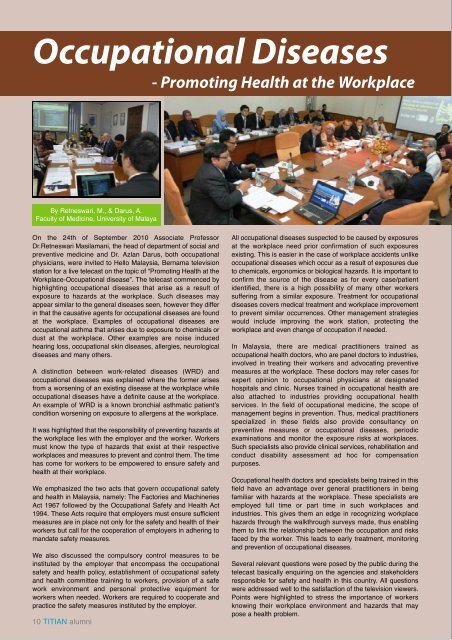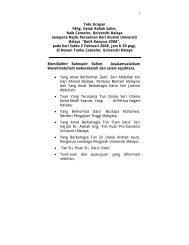Occupational Diseases- Promoting Health at the WorkplaceBy Retneswari, M., & Darus, A.Faculty of Medicine, University of <strong>Malaya</strong>On the 24th of September 2010 Associate ProfessorDr.Retneswari Masilamani, the head of department of social andpreventive medicine and Dr. Azlan Darus, both occupationalphysicians, were invited to Hello Malaysia, Bernama televisionstation for a live telecast on the topic of “Promoting Health at theWorkplace-Occupational disease”. The telecast commenced byhighlighting occupational diseases that arise as a result ofexposure to hazards at the workplace. Such diseases mayappear similar to the general diseases seen, however they differin that the causative agents for occupational diseases are foundat the workplace. Examples of occupational diseases areoccupational asthma that arises due to exposure to chemicals ordust at the workplace. Other examples are noise inducedhearing loss, occupational skin diseases, allergies, neurologicaldiseases and many others.A distinction between work-related diseases (WRD) andoccupational diseases was explained where the former arisesfrom a worsening of an existing disease at the workplace whileoccupational diseases have a definite cause at the workplace.An example of WRD is a known bronchial asthmatic patientʼscondition worsening on exposure to allergens at the workplace.It was highlighted that the responsibility of preventing hazards atthe workplace lies with the employer and the worker. Workersmust know the type of hazards that exist at their respectiveworkplaces and measures to prevent and control them. The timehas come for workers to be empowered to ensure safety andhealth at their workplace.We emphasized the two acts that govern occupational safetyand health in Malaysia, namely: The Factories and MachineriesAct 1967 followed by the Occupational Safety and Health Act1994. These Acts require that employers must ensure sufficientmeasures are in place not only for the safety and health of theirworkers but call for the cooperation of employers in adhering tomandate safety measures.We also discussed the compulsory control measures to beinstituted by the employer that encompass the occupationalsafety and health policy, establishment of occupational safetyand health committee training to workers, provision of a safework environment and personal protective equipment forworkers when needed. Workers are required to cooperate andpractice the safety measures instituted by the employer.10 TITIAN <strong>al<strong>um</strong>ni</strong>All occupational diseases suspected to be caused by exposuresat the workplace need prior confirmation of such exposuresexisting. This is easier in the case of workplace accidents unlikeoccupational diseases which occur as a result of exposures dueto chemicals, ergonomics or biological hazards. It is important toconfirm the source of the disease as for every case/patientidentified, there is a high possibility of many other workerssuffering from a similar exposure. Treatment for occupationaldiseases covers medical treatment and workplace improvementto prevent similar occurrences. Other management strategieswould include improving the work station, protecting theworkplace and even change of occupation if needed.In Malaysia, there are medical practitioners trained asoccupational health doctors, who are panel doctors to industries,involved in treating their workers and advocating preventivemeasures at the workplace. These doctors may refer cases forexpert opinion to occupational physicians at designatedhospitals and clinic. Nurses trained in occupational health arealso attached to industries providing occupational healthservices. In the field of occupational medicine, the scope ofmanagement begins in prevention. Thus, medical practitionersspecialized in these fields also provide consultancy onpreventive measures or occupational diseases, periodicexaminations and monitor the exposure risks at workplaces.Such specialists also provide clinical services, rehabilitation andconduct disability assessment ad hoc for compensationpurposes.Occupational health doctors and specialists being trained in thisfield have an advantage over general practitioners in beingfamiliar with hazards at the workplace. These specialists areemployed full time or part time in such workplaces andindustries. This gives them an edge in recognizing workplacehazards through the walkthrough surveys made, thus enablingthem to link the relationship between the occupation and risksfaced by the worker. This leads to early treatment, monitoringand prevention of occupational diseases.Several relevant questions were posed by the public during thetelecast basically enquiring on the agencies and stakeholdersresponsible for safety and health in this country. All questionswere addressed well to the satisfaction of the television viewers.Points were highlighted to stress the importance of workersknowing their workplace environment and hazards that maypose a health problem.
Report onthe InternationalStudentsBy International Student Centre, University of <strong>Malaya</strong>In the rapidly globalizing world of today, colleges and universitiesincreasingly require and, in fact, typically value the skill ofconducting research, international experience and knowledge ofother countries, cultures, and languages as both a personal andprofessional asset. The University of <strong>Malaya</strong> offers a truly uniqueexperience through its distinguished <strong>edu</strong>cation system andStudy Abroad - Student Exchange program. Through theprogram, students from overseas can pursue studies throughtaught courses or research in their field of interest and gainbroad perspectives on different cultures and background of theirpeers.As the aim of the University of <strong>Malaya</strong> is to establish aninternationally renowned institution of higher learning inresearch, innovation, publication and teaching, its unique<strong>edu</strong>cation system has been attracting international studentssince the first year of recruitment of international students in2007. In the past 4 years, admissions of foreign students andvisitors on <strong>edu</strong>cational and cultural fulltime and exchangeprograms have risen dramatically, reaching almost 4,000 in July,2010. This Spotlight describes the foreign student and exchangevisitor population in the University of <strong>Malaya</strong> and highlightsrecent policy and activity developments.Until last year, large n<strong>um</strong>bers of international students haveparticipated in our full-time undergraduate and postgraduateprograms, where the demographic composition shows that ofthe 3435 students enrolled until the first semester, 2010/<strong>2011</strong>academic year, 817 (58%) were degree students and 2518(42%) were Masters and PhD students. The majority of theseinternational students were classified as either from the Facultyof Engineering (490 or 15%) or Faculty of Computer Sciencesand IT (462 or 13%). However there is a fluctuation in then<strong>um</strong>bers at the second semester, 2010/<strong>2011</strong>. Up until 11F e b r u a r y, <strong>2011</strong>, there are 1139 international postgraduatestudents in the University of <strong>Malaya</strong>, including 774 Masters and365 Ph.D students; whilst the n<strong>um</strong>ber of undergraduate studentsrose to 973 from around 60 countries. This made a totalpopulation of 2112 international students.UM NewsInternational students were enrolled in three institutional types:Doctoral, Master's and Baccalaureate. According to the figureslisted above, currently baccalaureate institutions enrolled themost international students at 46%. Masterʼs institutions enrolled37% of the total population of international students. Finally,doctoral institutions enrolled the least n<strong>um</strong>ber at 1790 of thewhole international student population. Of these threeinstitutional types, the countries with the largest enrollments ofinternational students were: Iran (598 or 28% of the total studentenrollment), China (292 or 14%), Indonesia (213 or 10%) andSingapore (103).The UMSEP (University of <strong>Malaya</strong> Student ExchangeProgramme) focuses on cultural and <strong>edu</strong>cational exchanges forforeign exchange students ranging from degree to Ph.Dstudents in order to further cultural understanding and enhanceresearch cooperation between universities. This entire programis mainly handled by ISC (International Student Center), whichconcentrates on providing all international students, both fulltimeand exchange with better services and a comfortable and safestudying experience in Malaysia and thus upgrading theuniversityʼs world ranking. Till the end of 2010, under theleadership of the Deputy Registrar Mr. Yusoff Musa, ISC hasalready sent and recruited 2460 students successfully fromvarious countries all over the world. The rapid increase in then<strong>um</strong>ber of students enrolled indicates the concerted effort of allthe faculties and departments. The Faculty of Languages andLinguistics has the largest n<strong>um</strong>ber (244) of inbound studentsfollowed by the Faculty of Medicine, which absorbed 235students. A hundred and thirty five outbound students were sentto other universities by the Acade<strong>my</strong> of Islamic Studies, while theAcade<strong>my</strong> of Malay Studies sent 107 students. The ISC isdedicated to ensuring the students assimilate and are acceptedas part of the community in Malaysia by being a member of theirhost family: eating traditional meals, conversing, playing andstudying and visiting places of interest that will extend andinspire their insights. Airport pick-up services are also madepossible upon request by the home universities available toexchange students upon requirement of the home universities.In short, these foreign exchange students are immersed in anew way of life; joining the culture and community of their hostuniversity. Significantly, this happens at a time in their lives whenmany people make long-lasting friendships. Experience hasshown that this correspondence helps to eliminate many falseexpectations and to build friendship, trust and understanding.Through the years, ISC continues to recruit qualified hostfamilies for the home-stay program unless circ<strong>um</strong>stancesrequire the student to relocate. Each prospective host family isrequired to fill in an application covering the familyʼsbackground, interests and hobbies and an interviewwill be conducted with the members of the family toascertain the suitability of the family and their abilityto provide a good environment for the potentialexchange students. As part of the programme,city tours are often arranged to familiarize thestudents with world-famous places of interests,such as the Twin Towers, Putra Jaya, KLTower, etc. All these activities are aimed atensuring a fun-filled and beneficial studyingexperience for the exchange students.Once the foreign exchange studentprogramme ends, the students thenreturn to their home countries, bringingback new experience and friendshipwhich underlines the real meaning ofa cultural exchange.11 TITIAN <strong>al<strong>um</strong>ni</strong>




